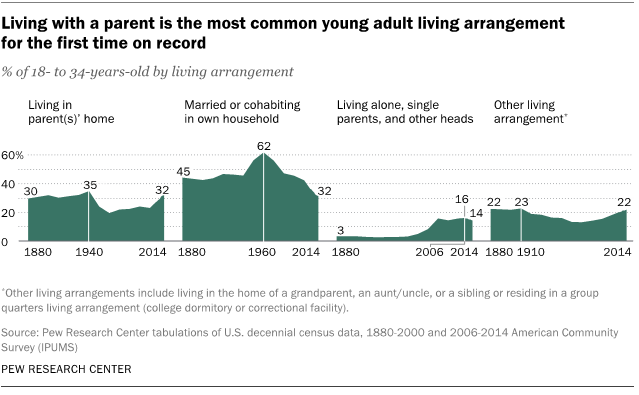The year 2014 appears to be a milestone in the unfolding living arrangements of the nation’s young adults. For the first time since 1880, young adults are more likely to be living with a parent than they are to be living with a romantic partner in their own household. 4 In 2014, 32.1% of 18- to 34-year-olds lived in their parents’ home, 5 eclipsing the 31.6% of young adults who were married or cohabiting and living in their own separate dwelling. 6 Prior to 2014 the most common living arrangement for young adults was to be in a romantic coupling (either married or cohabiting) living in their own household.
This living arrangement classification is solely based on the young adult’s relationship to the head of the household.

The overall share of young adults living in their parents’ home was not at a record high in 2014. This arrangement peaked around 1940 when roughly 35% of the nation’s 18- to 34-year-olds lived with mom and/or dad, compared with 32% in 2014. The share of young adults living in the home of their parent(s) hit a record low (20%) around 1960. Living with parents increased between 1960 and 1990, dipped in the 1990s, and has risen sharply in the new millennium.
Until recently, married or cohabiting young adults in their own separate household has been the most prevalent young adult living arrangement through recorded history, and it reached its zenith around 1960. The nuclear family was in its heyday around 1960, 7 and among young adults 62% were either married or cohabiting and living in their own household according to the 1960 Census. In 2014 about half that share are married or cohabiting and running their own household (32%). The rise and decline of married and cohabiting young adult households partly reflects changes in the age at first marriage. Young adults never married as young as they did around 1960 and they have not married as young since. 8 According to Census Bureau figures, the median age at first marriage reached a record low in 1956 at 20.1 years for women and 22.5 years for men. Age at first marriage was 22 and 26.1 years for women and men, respectively, in 1890. Today the typical age at first marriage is 27.1 years for women and 29.2 years for men. 9
The third category refers to young adults living alone, single parents running their own household, or unpartnered young adults who are the household head and living with others. 10 The share of young adults in this category peaked in 2006 at 16% and had fallen to 14% by 2014.
The fourth category – “other living arrangement” – refers to young adults who are not a head of household, the spouse or partner of the head, or the child of the head. Included in this category are the grandchild, niece/nephew or child-in-law of the head. This category also includes young adults unrelated to the head such as housemates, roommates, boarders or lodgers, as well as those living in group quarters (such as college dorms and correctional facilities).




